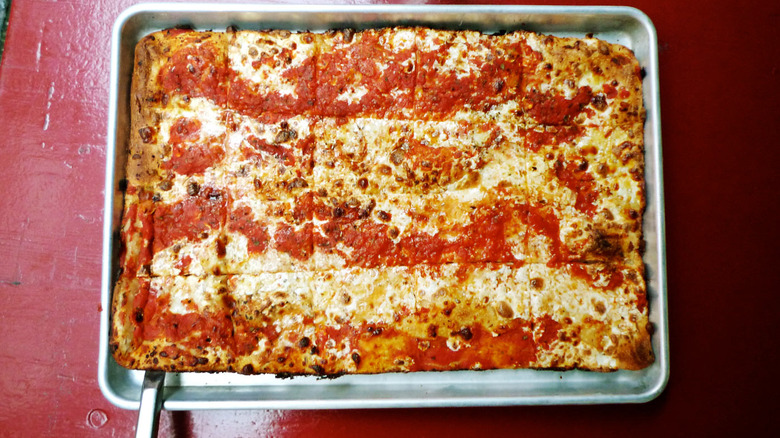What Grandma Pie Is & Where To Get It In NYC
Gran definitely knows best
One of life's great joys is discovering a dish that feels like an insider's secret. That's just what tasting my first bite of grandma pie—a crispy, pan-baked pizza covered with a garlicky tomato sauce—felt like. To learn more about the quintessential New York specialty with deep roots in Italian American culture, I chat with resident pizza expert Scott Wiener, founder of Scott's Pizza Tours and the nonprofit Slice Out Hunger.
According to Wiener, "grandma-style" is differentiated by the crust: It's a pizza you can make on a cookie sheet and usually isn't allowed to proof in the pan, unlike more prolific Sicilian pizza (a variety often confused with grandma style due to its similar shape). In comparison to Sicilian pies, "grandma is its much thinner, more dense cousin," Wiener says.
Grandma pie was a homemade delicacy decades before finding its way into pizzerias and, true to its namesake, was often the specialty of the family matriarch. In the late 1970s/early 1980s, the pies started showing up on menus in Long Island, with Umberto's in New Hyde Park credited as one of the first to offer them. And though the crispy square soon spread throughout the city, it has yet to attain the commercial popularity of the traditional, floppy New York slice.
One of Wiener's must-try versions comes from Luigi's Pizza in Park Slope, now run by the original owner's son, Giovanni Lanzo. The pizzeria opened in 1973 and has churned out an array of styles, but the "granma pie" has been a staple on the menu since the mid-1990s. I find Lanzo holding court behind the counter, serving pies and greeting the locals streaming in and out of his shop by name.
RELATED The Best-Kept Pizza Secret in NYC "
For Lanzo, grandma pie is an alternative that hits close to home. "My mother made bread once a week for the house, and with what [dough] was left, she would stretch out on regular aluminum trays and she would make pizza at home." He still uses his mother's recipe today and, showing that there's always room for variety when it comes to tradition, actually proofs his dough for a minimum of half a day. When cooked on a metal tray, it produces the crunchy bottom crust that defines grandma-style pizza.
"I'm partial to the grandma, because my mother made it. I still sit down and have a grandma, and I'll put an anchovy on it the way I grew up," Lanzo adds.
Recently, the grandma style has been making its way into the hearts and mouths of a wider audience. Wiener credits the thinner crust for the trend. "Because it's thinner than a Sicilian pizza, it's sort of taken on a comparative lightness to the preexisting square pizza that we've usually seen, especially in New York, where Sicilian is a thicker, rectangular pizza."
The pizza's appearance is also driving its rise in popularity. The sauce is often ladled on top of the cheese, standing in stark visual contrast to your typical NY slice. "Sauce gives an air of elegance, and when you see that in a pizzeria, it has a good look to it," Wiener says. And after the rise and proliferation of almost-paper-thin Neapolitan pizza, the grandma style offers a unique take on texture. "Grandma pizza is a really great alternative to the standard Neapolitan-influenced round pizza, because they hold up really well," he concludes. All the better for those of us who enjoy leftover slices just as much as pies straight from the oven.
Ashlie Hughes explores food and drink culture through her writing and photography. Follow her eating and drinking adventures on Instagram at @ashliehughes13.
